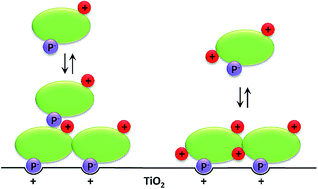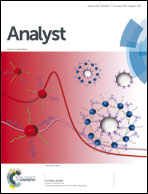Cooperative adsorption behavior of phosphopeptides on TiO2 leads to biased enrichment, detection and quantification†
Abstract
The adsorption behavior of phosphopeptides onto TiO2 surfaces was studied using the quartz crystal microbalance with dissipation monitoring (QCM-D) as the main experimental technique. The main focus is the characterization of the emergence of positive cooperativity under conditions where the peptides have a positively charged C-term. It is shown that when carrying no net charge, small water-soluble peptides as a rule develop positive cooperativity. The impact of the adsorption mechanism on the outcome of TiO2 based enrichment methods was investigated with the help of matrix assisted laser desorption-ionization mass spectrometry (MALDI-MS). The data presented illustrate how the phosphopeptide profile in the enriched material may deviate from that in the native sample, as cooperative phosphopeptides are overrepresented in the former. Furthermore, commonly employed washing and elution solutions may facilitate preferential release of certain peptides, leading to further bias in the recovered sample. Taken together, the results of the present study demonstrate that thorough understanding of the mechanisms behind the adsorption of phosphopeptides on the enrichment material is necessary in order to develop reliable qualitative and quantitative methods for phosphoproteomics.


 Please wait while we load your content...
Please wait while we load your content...